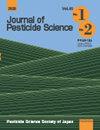中草药中有机氯农药残留
IF 1.5
4区 农林科学
Q2 ENTOMOLOGY
引用次数: 6
摘要
总结了十多年来有机氯农药(OCP)残留的常规检测结果,OCP残留包括六六六异构体(α、β、γ和δ-六六六)、滴滴涕类似物(p,p′-DDD、p,p’-DDE、o,p′-DDT和p,p'-DDT)、五氯硝基苯(PCNB)及其代谢产物(五氯苯胺和甲基五氯苯基硫醚(MPCPS)),采用QuEChERS法和GC-ECD联用,对37种中草药(CHM)的1665份样品进行了分析。根据亚洲药典设定的OCPs最大残留水平,人参中的PCNB污染以及西洋参中的DDT和PCNB总污染令人担忧。比较了人参不同部位OCP的残留情况。叶片和须根中的六六六总残留量,以及所有部位的滴滴涕和增殖细胞核抗原总残留量均超过了0.1的MRL mg/kg。总之,本研究为制药行业和消费者提供了关于中药中OCP残留的有意义的结果。本文章由计算机程序翻译,如有差异,请以英文原文为准。
Organochlorine pesticide residue in Chinese herbal medicine
Over ten-year routine inspection results on organochlorine pesticide (OCP) residue were summarized, OCPs residues, including BHC isomers (α, β, γ, and δ-BHC), DDT analogs (p,p′-DDD, p,p′-DDE, o,p′-DDT, and p,p′-DDT), and pentachloronitrobenzene (PCNB) and its metabolites (pentachloroaniline and methyl pentachlorophenyl sulfide (MPCPS)), in 1,665 samples for 37 types of Chinese herbal medicine (CHM) using the QuEChERS method coupled with the GC-ECD. Based on the maximal residue levels for OCPs set by Asian pharmacopeias, PCNB contamination in Ginseng radix as well as the total DDT and PCNB contamination in Panacis quinquefolii radix are of concern. OCP residues in different parts of Panax ginseng were also compared. The total BHC residue in leaf and fibrous root, as well as the total DDT and PCNB residue in all parts, exceeded MRL of 0.1 mg/kg. Overall, this study provided meaningful results about OCP residue in CHM for pharmaceutical industries and consumers.
求助全文
通过发布文献求助,成功后即可免费获取论文全文。
去求助
来源期刊

Journal of Pesticide Science
农林科学-昆虫学
CiteScore
4.30
自引率
4.20%
发文量
28
审稿时长
18-36 weeks
期刊介绍:
The Journal of Pesticide Science publishes the results of original research regarding the chemistry and biochemistry of pesticides including bio-based materials. It also covers their metabolism, toxicology, environmental fate and formulation.
 求助内容:
求助内容: 应助结果提醒方式:
应助结果提醒方式:


